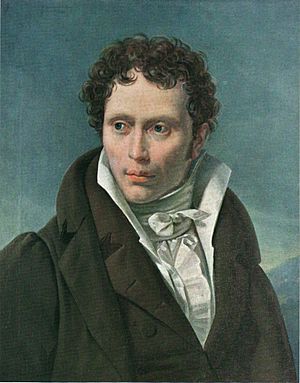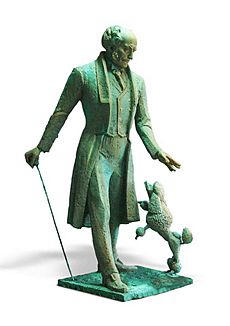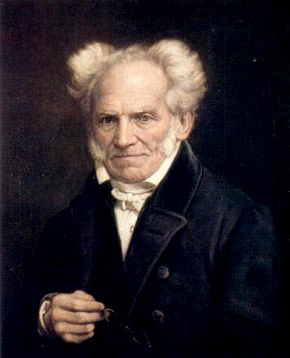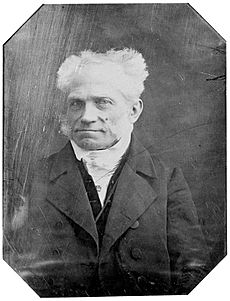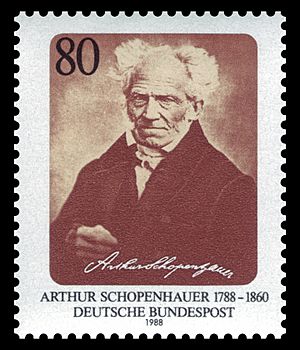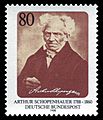Arthur Schopenhauer facts for kids
Quick facts for kids
Arthur Schopenhauer
|
|
|---|---|

Schopenhauer in 1859 (colorized photograph)
|
|
| Born | 22 February 1788 |
| Died | 21 September 1860 (aged 72) Frankfurt, German Confederation
|
| Nationality | German |
| Education |
|
| Era | 19th-century philosophy |
| Region | Western philosophy |
| School |
|
| Institutions | University of Berlin |
|
Main interests
|
Metaphysics, aesthetics, ethics, morality, psychology |
|
Notable ideas
|
Anthropic principle Eternal justice Fourfold root of the principle of sufficient reason Hedgehog's dilemma Philosophical pessimism Principium individuationis Will as thing in itself Criticism of religion Criticism of German idealism Schopenhauerian aesthetics Wooden iron |
|
Influenced
|
|
| Signature | |
Arthur Schopenhauer (born February 22, 1788 – died September 21, 1860) was an important German philosopher. He is most famous for his 1818 book, The World as Will and Representation. This book says that the world we see is shaped by a hidden, driving force called "will."
Schopenhauer built on the ideas of Immanuel Kant. He created a system of thought that was atheistic (meaning it didn't believe in God). He disagreed with other German philosophers of his time. Schopenhauer was one of the first Western thinkers to agree with many ideas from Indian philosophy. These ideas included asceticism (living simply) and the idea that the world is like an illusion. His work is often seen as an example of philosophical pessimism, which means he believed life was full of suffering.
During his lifetime, Schopenhauer's work didn't get much attention. But after he died, he became very influential in many areas. These included philosophy, literature, and science. His ideas about art, morality, and psychology influenced many famous people. Some of these include philosophers Friedrich Nietzsche and Ludwig Wittgenstein, scientists Albert Einstein, and writers Leo Tolstoy and Thomas Mann.
Contents
Arthur Schopenhauer's Life
His Early Years
Arthur Schopenhauer was born on February 22, 1788, in Danzig. This city was then part of the Polish-Lithuanian Commonwealth. His parents, Johanna and Heinrich Schopenhauer, came from rich German families. They were not very religious and supported the French Revolution. They also liked the ideas of republics and were interested in the world.
When Danzig became part of Prussia in 1793, his father moved the family to Hamburg. Hamburg was a free city with its own government. Arthur's only sister, Adele, was born in 1797.
In 1797, Arthur went to live in Le Havre, France, with a family friend. He enjoyed his two years there and learned to speak French. He also became good friends with Jean Anthime Grégoire de Blésimaire. Arthur started playing the flute around 1799.
In 1803, he traveled with his parents on a trip around Europe. His father, Heinrich, wanted Arthur to learn about business during this trip. Arthur later regretted this choice because the business training was very boring. He also spent time at a school in Wimbledon, England. He didn't like the strict religious rules there.
Family Changes and Studies
In 1805, Arthur's father, Heinrich, died by drowning. Heinrich had struggled with anxiety and depression. Arthur himself showed similar moods when he was young. He believed he got this from his father.
Heinrich left a large amount of money for his family. Arthur received his share when he became an adult. He invested it carefully, which gave him enough money to live on. This meant he didn't have to work a regular job.
After leaving his business training, Arthur decided to study at the Ernestine Gymnasium, Gotha. He enjoyed social life there, but his mother worried about how much money he spent. He left the school after writing a poem that made fun of a teacher.
Arthur's mother, Johanna, moved to Weimar with his sister Adele. Weimar was a center for German writers and artists. Arthur and his mother had a difficult relationship. She found him hard to live with and criticized his moodiness. Arthur also criticized her for being financially careless.
Arthur moved to Hamburg to live with his friend Jean Anthime. He spent two years working as a merchant to honor his father. He worried about starting a new life as a scholar because he had trouble learning Latin. Latin was needed for university studies.
University Life
Arthur moved to Weimar but did not live with his mother. Their relationship got worse because of their different personalities. He accused his mother of wanting to remarry, which he thought was disrespectful to his father. His mother told him to improve his behavior.
Arthur focused on his studies, which went well. He also enjoyed social events like parties and theater. His mother had a famous social gathering (salon) that included famous people like Goethe. Arthur went to these parties hoping to meet Goethe.
In 1809, he went to the University of Göttingen. He chose to study medicine because he was interested in science. His professor, Gottlob Ernst Schulze, told him to focus on Plato and Immanuel Kant. Around 1810–11, Arthur decided to switch from medicine to philosophy.
In 1811, he moved to the University of Berlin. He attended lectures by famous philosophers like Johann Gottlieb Fichte. But Schopenhauer often disagreed with their ideas. He became very critical of religion and leaned towards atheism. He preferred to learn by reading on his own. He read works by Plato, Kant, and many scientific books.
Early Writings
In 1813, Schopenhauer left Berlin quickly because he feared being forced into military service. He went to Rudolstadt and wrote his first important work, On the Fourfold Root of the Principle of Sufficient Reason. This book was about how we understand the world.
He sent his book to Goethe, who was impressed by Arthur's intelligence. They discussed Goethe's ideas about color theory. Schopenhauer soon wrote his own book on colors, On Vision and Colors. Their disagreements eventually made Goethe keep his distance.
While in Weimar, Schopenhauer met Friedrich Majer, who introduced him to Eastern philosophy. Schopenhauer was very impressed by the Upanishads from India. He called them "the production of the highest human wisdom." He also admired the Buddha and Buddhism. He believed these ideas were as important as those of Plato and Kant.
In 1814, Schopenhauer moved to Dresden. He worked on his most important book, The World as Will and Representation. He finished it in 1818. The book didn't sell well at first.
In 1818, he took a year-long trip to Italy. He visited many cities like Venice and Rome. He enjoyed art and continued his philosophical thinking. During this time, he learned that his family was having financial problems. He helped his sister Adele, and their relationship grew closer.
He returned to Dresden and then moved to Berlin to become a university professor. He tried to schedule his lectures at the same time as the famous philosopher G. W. F. Hegel. Schopenhauer thought Hegel was a "clumsy charlatan." Only five students came to Schopenhauer's lectures, so he stopped teaching at the university.
Later Life and Fame
After leaving academia, Schopenhauer traveled more. He visited cities like Leipzig and Florence. He learned Spanish to read his favorite authors in their original language. He tried to publish his translations but failed. His attempts to teach at universities also failed.
Schopenhauer sometimes wanted to marry. He had a relationship with a dancer named Caroline Richter. He offered to take her with him when he left Berlin during a cholera outbreak, but she refused to leave her son.
He moved to Frankfurt in 1833 and lived there for the rest of his life. He lived alone with his pet poodles. In 1836, he published On the Will in Nature. He also won a prize for his essay "On the Freedom of the Will". However, another essay, "On the Basis of Morality", was rejected. He published both essays together as The Two Basic Problems of Ethics.
Schopenhauer started to gain followers, mostly people outside of universities. One of his early supporters was Julius Frauenstädt, who wrote articles promoting his ideas. In 1848, Schopenhauer saw violent protests in Frankfurt. He was worried about his safety and property. He even welcomed soldiers who wanted to shoot revolutionaries from his window.
In 1851, Schopenhauer published Parerga and Paralipomena. This book contained essays that added to his main work. It was his first widely read and successful book. Many academic philosophers liked his writing style but didn't take his philosophy seriously.
As he became more famous, people visited places where he had lived. They also bought copies of his paintings and photographs. He complained that he still felt lonely because he wasn't very social.

Schopenhauer stayed healthy in his old age. He believed this was because he took regular walks and got enough sleep. He continued to read, write, and correspond with others. His notes from these years were published after he died as Senilia.
In the spring of 1860, his health began to decline. He had trouble breathing and heart problems. He died on September 21, 1860, at the age of 72. He died peacefully at home.
Schopenhauer's Philosophy
The World as We See It
Schopenhauer believed his philosophy continued the work of Immanuel Kant. Kant said that the world we experience is just how things appear to us in our minds. Schopenhauer agreed that our knowledge of the world is always indirect.
He started his main book by saying: "The world is my representation." This means everything we know and see exists only as an object in our minds. Everything in the world depends on someone perceiving it.
How We Perceive Things
Schopenhauer believed that our minds actively create the world we see. Our senses give us raw information, but our intellect organizes it. For example, when we see, our mind figures out that two images from our eyes come from one object. It also flips the images on our retinas and helps us see depth.
He stressed that perception is an intellectual process. Our senses provide the basic material, and our mind builds the world from it.
The World as Will
In his book, Schopenhauer also explored what the world is beyond how it appears to us. He called this the "thing-in-itself" or "noumena." He argued that the true nature of everything is "will."
The world we see has many different things and is organized by space and time. But the world as "will" exists outside of space and time. Even though the world appears as many objects, each one has the same blind desire to exist and live. Human reason is just a small part of this will. Schopenhauer believed this endless, directionless striving leads to suffering.
Schopenhauer thought that we can find relief from suffering. This happens when we realize that our individual selves are just an illusion. A wise person understands that everything is connected and that life is full of struggle and pain.
To escape suffering, people can practice asceticism. This means living a simple life and denying one's desires. This helps to quiet the "will" and brings a peaceful state free from wanting or suffering.
Art and Beauty

Schopenhauer believed that human "willing" (our desires and cravings) causes suffering. A temporary way to escape this pain is through enjoying art and beauty. When we appreciate art, we stop thinking about individual things. Instead, we focus on the eternal, perfect "Ideas" behind them.
In this state, we are no longer separate from the art. It's like the object exists without anyone seeing it, and the viewer and the art become one. Our minds are completely filled by the image.
When we experience art this way, we stop being individuals who suffer. We become a "pure, will-less, painless, timeless" observer. This observer only sees the perfect Ideas, not individual things.
Schopenhauer thought music was the purest form of art. He believed it showed the "will" itself directly, without needing to appear as an individual object. Music, he said, is a universal language that everyone can understand.
Ethics and Morality
Schopenhauer said that the purpose of ethics is not to tell us what we *should* do. Instead, it's to understand why people act morally. He believed philosophy should explain what already exists.
He thought that two individuals might appear separate, but deep down, they are not. An egoistic person focuses only on their own interests. But an altruistic person (someone who cares about others) feels the suffering of others as their own. For example, a compassionate person cannot hurt animals because they feel connected to all living things.
What drives an altruistic person is compassion. The suffering of others is not something they ignore. They feel a connection to all beings. So, compassion is the foundation of morality.
Eternal Justice
Schopenhauer believed that nature is a harsh struggle for survival. Individual things can only exist by consuming others. The "will" (the underlying force of everything) has to destroy itself to experience pleasure. This is a basic part of the will.
Unlike human justice, which punishes bad deeds over time, "eternal justice" is always present. It doesn't depend on human rules. There are no delays or escapes from it. Instead, punishment is directly linked to the offense. The person who causes suffering and the person who suffers are connected.
Suffering, for Schopenhauer, is the result of our desire for pleasure. He thought this idea was present in the Christian idea of original sin and in Eastern religions through the idea of rebirth.
Quietism
Someone who truly understands suffering will see it everywhere. Instead of trying to find individual happiness, they will dislike life itself. This is because they know life is always connected to suffering.
Those who have this deep understanding cannot fully embrace life. They practice asceticism and quietism. This means they are not easily moved by desires. They don't worry about their own well-being. They accept hardship without fighting it. They welcome poverty and don't try to avoid death. Schopenhauer called this the "denial of the will to live."
Human life is a constant struggle for satisfaction. Instead of continuing this struggle, ascetics stop it. It doesn't matter if they follow Christian or Dharmic religions. Their way of life comes from a deep, intuitive understanding.
Psychology and the Will to Live
Schopenhauer believed there was a powerful force inside humans that was stronger than reason. He called it the "Will to Live." This is a natural drive in all creatures to stay alive. It also pushes us to have children.
Political and Social Ideas
Government and Society
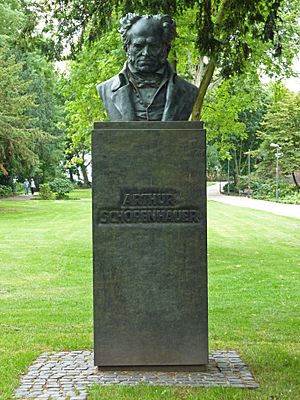
Schopenhauer's political ideas were connected to his ethics. He believed in a limited government. He agreed with Thomas Hobbes that the state is needed to control people's destructive tendencies. He also supported separate branches of government: legislative, judicial, and executive. He thought a monarch (a king or queen) could be an impartial leader.
He believed that monarchy was "natural to man." He thought that in monarchies, intelligence had a better chance against foolishness. He disliked republicanism (a system where citizens elect representatives). He thought it was "unnatural to man" and bad for intellectual life.
Schopenhauer admitted he didn't think much about politics. He was proud of how little attention he paid to daily political events. He often criticized Germany and Germans.
Punishment
Schopenhauer said that the government punishes criminals to stop future crimes. Punishment puts a stronger reason not to commit a crime. He said this idea wasn't new and had been discussed by philosophers like Plato and Hobbes.
Views on People and Beliefs
Schopenhauer was strongly against slavery. He condemned slave owners, especially those who were religious, for how they treated innocent enslaved people. He called the slave-holding states of North America a "disgrace to the whole of humanity."
He also had strong negative views about Judaism. He argued that Christianity was a rebellion against the materialistic ideas of Judaism. He thought Christianity had an ethical approach influenced by Indian ideas of spiritual self-control.
Views on Women
In his 1851 essay "On Women," Schopenhauer criticized what he called "Teutonico-Christian stupidity" for overly praising women. He wrote that women are "childish, frivolous and short-sighted." He thought they lacked artistic skills and a sense of justice. He also claimed that "woman is by nature meant to obey."
However, he also gave some compliments. He said women are "more sober in their judgment than [men] are" and more sympathetic to others' suffering.
Later in his life, when he met sculptor Elisabet Ney, he was impressed by her intelligence and independence. He told a friend that if a woman rises above the average, "she grows ceaselessly and more than a man."
Heredity and Eugenics
Schopenhauer believed that personality and intelligence were inherited. He quoted old sayings that brave people come from brave people. He thought a person inherited their intelligence from their mother and their character from their father.
This belief shaped his view of love. He thought that the goal of all love was very important. It was about "the composition of the next generation." He believed it was about the future of the human race. This led to his ideas on eugenics, or "good breeding."
Some experts say that Schopenhauer's ideas about inequality and eugenics influenced Friedrich Nietzsche. Nietzsche first saw Schopenhauer as his teacher.
Animal Welfare
Because of his philosophy, Schopenhauer cared deeply about animal welfare. He believed that all individual animals, including humans, are expressions of the same underlying "Will." He thought that since every living thing has this "will," humans and animals are fundamentally the same.
He said that a good person would feel sympathy for animals because they are "fellow sufferers." In 1841, he praised groups that worked to prevent cruelty to animals. He even argued against using the pronoun "it" for animals. He thought this made people treat them like objects.
Schopenhauer was very attached to his pet poodles. He disagreed with philosophers who thought animals were just tools for humans.
Schopenhauer's Interests
Schopenhauer had many interests. These included science, opera, and literature.
As a student, he went to more science lectures than philosophy ones. He kept a strong interest in science throughout his life. His personal library had nearly 200 science books.
He spent many evenings at the theater, opera, and ballet. He especially liked the operas of Mozart and Rossini. Schopenhauer thought music was the highest art form. He played the flute his whole life.
He knew many languages, including German, Italian, Spanish, French, English, Latin, and ancient Greek. He loved reading poetry and literature. He especially admired Goethe, Petrarch, and Shakespeare.
In philosophy, he said his most important influences were Kant, Plato, and the Upanishads.
Thoughts on Other Philosophers
Bruno and Spinoza
Schopenhauer saw Bruno and Spinoza as philosophers who were ahead of their time. He said they both believed that even though the world looks diverse, it is still one single being. He noted that their philosophies didn't offer much on ethics.
Immanuel Kant
Kant's philosophy was very important to Schopenhauer. He used Kant's ideas as the basis for his own work. Schopenhauer greatly praised parts of Kant's book Critique of Pure Reason. He believed Kant proved what earlier philosophers had only guessed.
In his study, Schopenhauer had busts of both Buddha and Kant.
Schopenhauer dedicated a large part of his main book, The World as Will and Representation, to criticizing Kant's philosophy. He praised Kant for separating how things appear to us from their true nature.
Other German Philosophers
Schopenhauer did not respect the leading philosophers who came after Kant. These included Johann Gottlieb Fichte, F. W. J. Schelling, and G. W. F. Hegel. He thought they were not true philosophers. He believed they were only interested in their own careers.
He called Hegel a "commonplace, inane, loathsome, repulsive, and ignorant charlatan." Schopenhauer wrote that Hegel had a very bad influence on philosophy and German literature. He felt it was everyone's duty to fight against Hegel's ideas.
Influence and Legacy
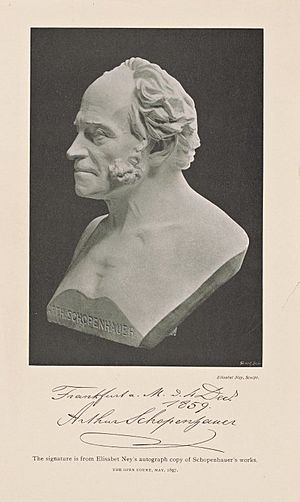
Schopenhauer was the most influential German philosopher until World War I. His ideas became the starting point for many new philosophers. His work changed intellectual discussions. Even movements that disagreed with him had to address his ideas.
The French writer Maupassant said that even those who hated Schopenhauer seemed to carry parts of his thoughts. Other 19th-century philosophers who were influenced by him include Friedrich Nietzsche and Volkelt.
Schopenhauer's books were read by many physicists, including Albert Einstein and Schrödinger. Einstein called Schopenhauer's thoughts a "continual consolation" and a genius. Schrödinger even considered switching from physics to philosophy after reading Schopenhauer.
Schopenhauer is most famous for his influence on artists. Richard Wagner was one of the first and most famous followers of Schopenhauer's philosophy. Schopenhauer, however, preferred Mozart and Rossini's music. He has been called "the artist's philosopher."

Under Schopenhauer's influence, Leo Tolstoy became convinced that the truth of all religions was in giving up one's self. Tolstoy said that Schopenhauer was "the greatest genius among men." He felt that what he wrote in War and Peace was also said by Schopenhauer.
Jorge Luis Borges said he never wrote a full account of his worldview because Schopenhauer had already done it for him. Other writers influenced by Schopenhauer include Thomas Mann and Herman Melville.
Sergei Prokofiev, a composer, became fascinated with Schopenhauer's ideas. He said that Schopenhauer "gave me a spiritual world and an awareness of happiness."
Friedrich Nietzsche became interested in philosophy after reading The World as Will and Representation. He respected Schopenhauer and dedicated an essay to him.
Early in his career, Ludwig Wittgenstein adopted some of Schopenhauer's ideas. However, later in life, Wittgenstein thought Schopenhauer was a shallow thinker. His friend Bertrand Russell also had a low opinion of Schopenhauer.
The Dutch mathematician L. E. J. Brouwer used Kant's and Schopenhauer's ideas in his philosophy of mathematics. He believed mathematics was a purely mental activity.
Schopenhauer's philosophy has appeared in modern works, like the novel The Schopenhauer Cure. His ideas about philosophical pessimism have also influenced contemporary thinkers and popular TV series like True Detective. He is sometimes seen as the founder of antinatalism, the idea that it's wrong to bring new life into the world.
Images for kids
-
Grave at the Hauptfriedhof in Frankfurt
-
In his main work, Schopenhauer praised the Dutch Golden Age artists, who "directed such purely objective perception to the most insignificant objects, and set up a lasting monument of their objectivity and spiritual peace in paintings of still life. The aesthetic beholder does not contemplate this without emotion."
-
Bust in Frankfurt
-
Sculpture of Schopenhauer by Elisabeth Ney
-
Schopenhauer depicted on a 500 million Danzig papiermark note (1923)
See also
 In Spanish: Arthur Schopenhauer para niños
In Spanish: Arthur Schopenhauer para niños
- Antinatalism
- Existential nihilism
- Eye of a needle
- God in Buddhism
- Massacre of the Innocents (Guido Reni)
- Misotheism
- Mortal coil
- Nihilism
- Post-Schopenhauerian pessimism



